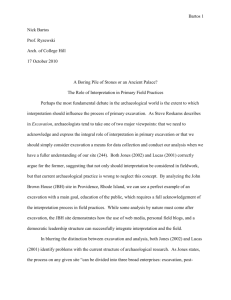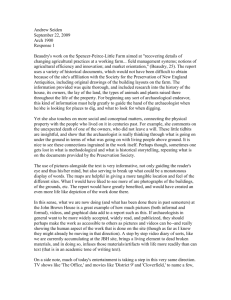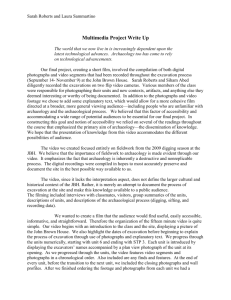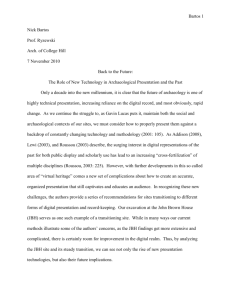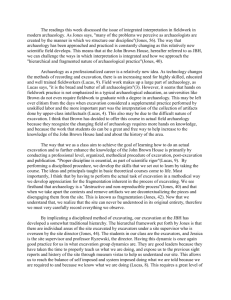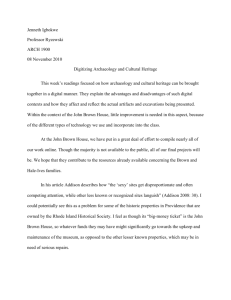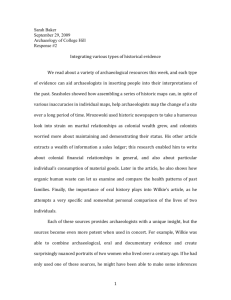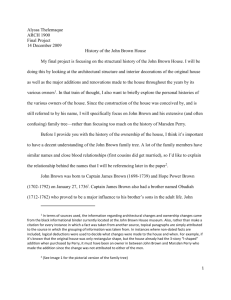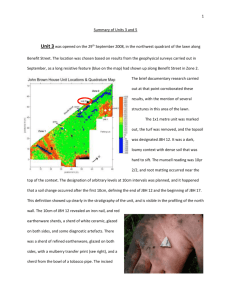ARCH1900.FinalProject.Unit6.Report
advertisement
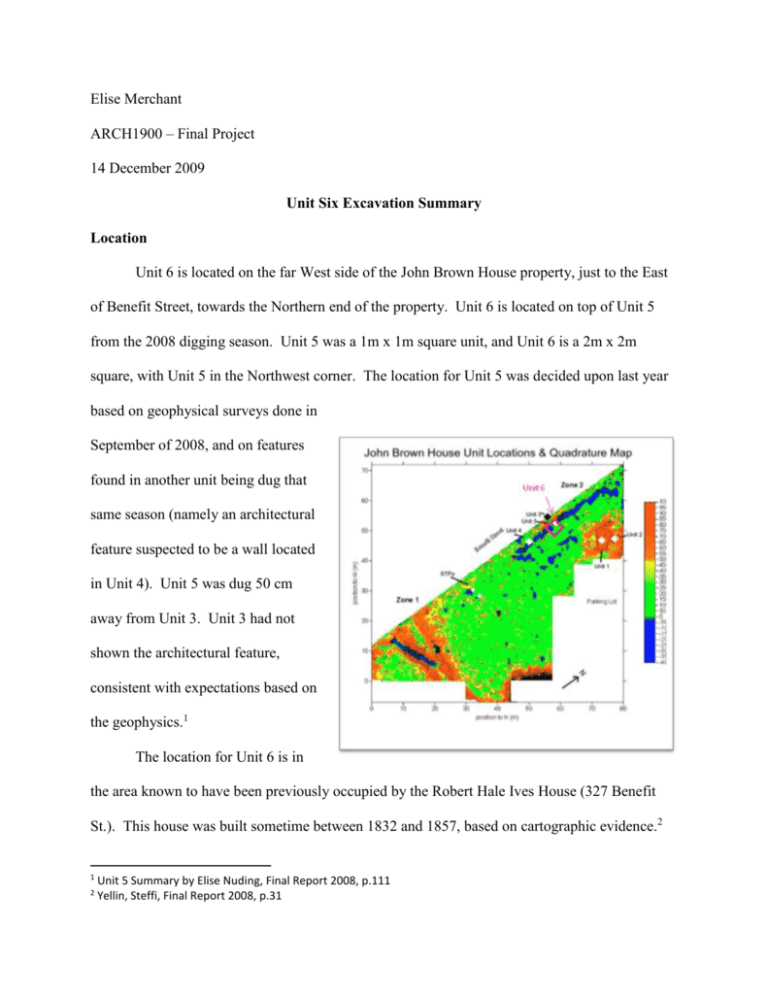
Elise Merchant ARCH1900 – Final Project 14 December 2009 Unit Six Excavation Summary Location Unit 6 is located on the far West side of the John Brown House property, just to the East of Benefit Street, towards the Northern end of the property. Unit 6 is located on top of Unit 5 from the 2008 digging season. Unit 5 was a 1m x 1m square unit, and Unit 6 is a 2m x 2m square, with Unit 5 in the Northwest corner. The location for Unit 5 was decided upon last year based on geophysical surveys done in September of 2008, and on features found in another unit being dug that same season (namely an architectural feature suspected to be a wall located in Unit 4). Unit 5 was dug 50 cm away from Unit 3. Unit 3 had not shown the architectural feature, consistent with expectations based on the geophysics.1 The location for Unit 6 is in the area known to have been previously occupied by the Robert Hale Ives House (327 Benefit St.). This house was built sometime between 1832 and 1857, based on cartographic evidence.2 1 2 Unit 5 Summary by Elise Nuding, Final Report 2008, p.111 Yellin, Steffi, Final Report 2008, p.31 The house was knocked down by Marsden Perry sometime between 1923 and 1926.3 It is impossible to be certain that the feature found in Unit 6 (and in Unit 5 before it) was part of the Hale Ives house, but given the significant size of the feature it seems likely that it was at least associated with the building.4 Excavation Methods The excavation of Unit 6 was performed by Alyssa Thelemaque, Alex Mittman, Bridget Smith and Elise Merchant, under the direction of teaching assistant Elise Nuding. To begin the excavation of Unit 6, the Southwest corner was designated the datum point, being the highest point initially. Prior to any digging, the Northwest corner was 3.5 cm bd (below datum), the Northeast corner was 12.5 cm bd, and the Southeast corner was 6.5 cm bd. Excavation initially proceeded with shovel shaving, until the first context after the topsoil was encountered, at which point the trowelling was employed. All the soil removed from the unit was sifted with ¼” mesh.5 Stratigraphy Unit 6 contained 5 different contexts. The topsoil layer was JBH 46. On the West half of the Unit, JBH 48 was the next context, designated by a change in soil color and consistency (large quantities of gravel and rubble “fill”). JBH 46 persisted on the East side of the Unit beyond the start of JBH 48.6 The next soil layer to be hit on the East side of the Unit was JBH 52, causing context JBH 46 to finally be closed. The 3 Yellin, Steffi, Final Report 2008, p.32 Nuding, Elise, Final Report 2008, p.118 5 Excavation form for JBH 46 6 Excavation form for JBH 46 4 context JBH 52 also included a very small triangular area in the Southwest corner of the unit. This patch was surrounded by the South and West walls and JBH 48 (and late JBH 54). JBH 52 was designated due to a change in soil color. The soil became mottled with a bright yellowish orange (the Munsell value of which was unfortunately not noted), with the background color of the soil remaining the same. JBH 52 persisted on the East side of the unit (and in the Southwest corner) until the end of the excavation.7 The next context designated was JBH 54, which occurred directly underneath JBH 48, except for a small patch of JBH 48 along the West wall of the unit in the center of the wall, where JBH 48 persisted past the level where the rest of the context had left off. The transition from JBH 48 to JBH 54 was gradual, marked by a change in rubble consistency. JBH 54 was still gravelly, but had denser sandier soil than JBH 48. This gradual change unfortunately meant that some of JBH 54 was excavated as JBH 48 before the decision to declare a new context was made.8 The very last context declared was JBH 61. JBH 61 is a feature level: a collection of sizeable rocks uncovered forms a wall-like feature (feature number 3) which runs through the same area that had been covered by JBH 54 and JBH 48. This feature is the same as the one 7 8 Excavation form for JBH 52 Excavation form for JBH 54 unearthed in Unit 5, which was then designated feature number 7. Digging was closed with the Southwest corner at 46 cm bd, the Northwest corner 45.5 cm bd, the Northeast corner 24 cm bd, and the Southeast corner 33 cm bd. JBH 46 The topsoil layer was designated JBH 46. This layer was excavated primarily by shovel shaving. The topsoil layer was a dark grayish brown soil color (Munsell value 10YR 3/2) and was heavily permeated by roots which frequently required the use of root cutters.9,10 This soil layer corresponds with the topsoil layer from Unit 5, JBH 27, which had a Munsell value of 7.5YR 2.5/1, and was described as “sandy silty soil of loose compaction”. 11 Context JBH 46 extended fairly deep on the East side of the unit, ending where JBH 52 begins, at 19 cm bd in the center of the North wall, 20.5 cm bd in the Northeast corner and 15 cm bd in the Southeast corner. The soil consistency had started to change on the East side prior to the declaration of JBH 52, with increasing clay content and mottled yellow and black colors. However, the changes were not drastic enough to declare a new context.12 On the West side of the Unit (directly South of Unit 5), JBH 46 does not extend down as far. In the Northwest corner, JBH 48 begins at 6.25 cm bd, and in the Southwest corner JBH 48 begins at 9 cm bd. The first soil color change was noted in the Southwest area of the unit, towards the center, at approximately 7.5 cm bd. At this point, 9 Excavation form for JBH 46 Elise M’s Excavation Blog, http://proteus.brown.edu/archaeologyofcollegehill/9082 11 Nuding, Elise, Final Report 2008, p. 111 12 Excavation form for JBH 46 10 a new soil layer with a lighter yellow color (Munsell value 10YR 4/3) and a sandy consistency was found and designated JBH 48.13 The finds from JBH 46 included pieces of brown, green and clear glass, pieces of a glass measuring cup, a wire nail, two plastic beads, a rim piece of a clay pipe, a plastic soda bottle cap gasket, a piece of brown rubber, pieces of brick, pieces of shell, a piece of plastic coffee lid and ceramics (whiteware and creamware). The two artifacts in this context which are clearly modern are the plastic soda bottle cap gasket and the piece of plastic coffee lid (although the plastic beads are also fairly modern). The plastic coffee cup lid provides a TPQ (terminus post quem) date of 1997, as this is the date of the first patent for a hot cup lid that has the indentations for the holding a portion of the lid folded back to create a drinking hole.14 The other finds from JBH 46 all potentially could be modern, or could have been re-deposited from earlier times (with the exception of the clay pipe rim piece, which was undoubtedly re-deposited). The finds from the corresponding context in Unit 5, JBH 27, included brick fragments, glass shards and a nail, all of which are potentially modern as well. 15 13 Excavation form for JBH 46 U.S. Patent number 5,613,619 15 Nuding, Elise, Final Report 2008, p. 111 14 JBH 48 The first context to emerge below the topsoil layer was JBH 48. This context was designated based on a change in soil consistency. Where the soil from JBH 46 had been “moist, soft, dark soil”, the soil in JBH 48 was “sandy, gravelly, yellowish soil” (Munsell value 10YR 4/3). JBH 48 extended from the entire N-S length of the unit, on the West half. When JBH 48 was declared, the Northwest corner was 6.25 cm bd, the Southwest corner was 9 cm bd and at two points in the center of the new context the soil was 10 cm bd and 7 cm bd. The temporally diagnostic finds for this unit include cut and wire nails, whiteware, creamware, a piece of ceramic insulation, a piece of molded glass, and a pencil fragment. This pencil fragment provides the TPQ date for this context, as it has yellow paint on the outside. The first yellow pencil in history was documented in 1854. However, it was not until 1893 that yellow pencils were being imported and manufactured in the United States.16 Therefore, the TPQ date for the context is 1893. However, since the context appears to be rubble fill and given the location of the unit (based on cartographic evidence and the geophysical survey done), it seems unlikely that this context was deposited prior to the demolition of the house in the 1920s as the unit appears to be in or at least on the edge of the Hale Ives House. Given this information, and the commonality of yellow pencils through today, the TPQ provided by this artifact should be examined critically. 16 See Elise’s Object Bio on pencil fragment There were many architectural finds among the fill which composed context JBH 48. These included many pieces of brick (quite a few of which were nearly whole) and mortar, nails (both cut nails and wire nails, including one 11.5 cm spike), other unidentifiable iron pieces, asphalt with a cobblestone imbedded within it, pieces of slate roofing, a piece of ceramic electrical insulation and a clay tube which is potentially a piece of a drainpipe.17 These architectural finds may have come from the Robert Hale Ives House, possibly deposited when the house was demolished by Marsden Perry sometime before 1926.18 It is equally possible that the architectural finds came from the Hale Ives House, but were re-deposited in context JBH 48 at a date later than the demolition of the house in the 1920s. During excavation, the gravelly nature of JBH 48 and the shape of the context led the excavators to hypothesize that this context composed a pathway which ran roughly North-South across the unit. If this was indeed the case, the rubble from the demolition of the house may have been utilized to increase the volume of the gravel fill of the path. Along these same lines, it is always possible that the architectural finds came from somewhere else entirely, deposited here at the time of the (possible) path formation, although this seems less likely. 17 18 Excavation form for JBH 48 Yellin, Steffi, Final Report 2008, p. 32 Documentary research has supported the hypothesis that JBH 48 is the remnants of a gravel path. A photograph from 1949 (shortly after the Rhode Island Historical Society obtained the house, after the demolition of the Hale Ives House) shows a light line running from the West side of the John Brown house around the yard. This lighter line appears to be a pathway, but the photograph was taken from too high up to be certain. However, a photograph from December of 1935 showing the West side of the John Brown House clearly shows the start of a gravel pathway. It appears that unit 6 is located at least approximately on the line of the pathway, which is supported by shape of the pathway in the photograph, which matches the shape of the pathway turned up in our unit (running approximately NorthSouth). Based on the timing of the photographs, the pathway was most likely built by Marsden Perry, who potentially built the path following the demolition of the Hale Ives House, using the rubble as fill for the pathway. This pathway was most likely demolished sometime after May 1964, when the parking lot for the John Brown House was created. 19 JBH 52 JBH 52 was the next context underneath the topsoil context (JBH 46) to be uncovered on the East side of Unit 6. In addition, a small area in the Southwest corner was also designated to 19 See Pridham, Julie, Final Report 2009 be part of this same context. This context was declared based on a soil color change. The soil in JBH 52 is a mottled yellowy-orange, whose Munsell value was unfortunately not documented. The Northeast corner of the context was initially 20.5 cm bd, the Southeast corner initially 15 cm bd, and a point in the center of the unit along the border between JBH 52 and JBH 48 initially 16 cm bd. This context was fairly slow to excavate due to the high root content, including one very large root in the Northeast corner of the unit. Also of note, a distinct patch of sand (approximately 10 cm2) was found right next to the root.20 The finds from JBH 52 include pieces of unidentifiable metal, cut nails, fragments of glass (colorless, green, pink-tinted, and dark green), a fragment of porcelain bone china, china (including pearlware with a scalloped edge, a piece of a pearlware dish, and creamware) and a small molded button. The TPQ date for the unit is given by a piece of blue-printed whiteware, which has a date range of 1840-1860.21 JBH 52 was the lowest context reached in the East half of the unit by the end of the excavation. This was in part because the focus of excavation was on the West half of the unit, due to the gravel and rubble fill of JBH 48 and the feature uncovered in JBH 61. The Northeast corner was particularly higher than the 20 21 Excavation form for JBH 52 Florida Museum of Natural History, Mean Ceramic Manufacturing Dates. rest of the unit, as even within the digging on the East side of the unit more attention was paid to the center of the unit (the transition between JBH52 and JBH61), and the feature (and JBH 48 before it) ran much closer to the East edge on the South side of the unit. At closing, the Northeast corner was 24 cm bd, the Southeast corner was 33 cm bd, the middle of the unit (border of JBH 52 and JBH 61) was 34 cm bd, and the boundary between the two contexts was 33 cm bd on the North edge of the unit.22 JBH 54 JBH 54 was declared following a consistency in the soil change from JBH 48. There was no clear distinction between the two contexts, and consequently some of JBH 54 was excavated as JBH 48. JBH 54 is still gravelly, although the soil is sandier and denser, packed around medium to small sized stones. Additionally, the architectural rubble present in JBH 48 is no longer found in JBH 54. A small patch in the center of the West wall of the unit (next to the Southwest corner of Unit 5) continued to be JBH 48, based on soil consistency. The finds from this unit included many chunks of mortar, a ridged piece of molded glass corresponding to one found in JBH 48 (potentially explained by the excavation of some of JBH 54 as JBH 48), asphalt attached to a cobblestone, concrete, pieces of brick, a small shard of slate, a piece of whiteware, a marble slab, and iron pieces (one thin, slightly curved plane-like piece approximately 5 cm2, two large iron fixtures, cut 22 Excavation form for JBH 52 nails and a cut spike, and a small finishing nail).23 The TPQ date for the context comes from the small finishing nail, which dates from somewhere between 1900 and the present.24 At about 30 cm bd at the North side of the unit, the same large stones as the ones reached in Unit 5 started to appear. The soil around these stones contained much of the mortar found in JBH 54, as well as a fairly high sand content. This find prompted the declaration of the last context of Unit 6, JBH 61. JBH 61 JBH 61 is the only feature context in Unit 6. The wall-like feature is feature number 3. This feature is the same as feature number 7 from Unit 5 in 2008. In fact, starting with JBH 61, Unit 5 is no longer a distinction area within Unit 6, as the bottom level of Unit 5 was finally reached. The feature runs across the unit approximately following the same path as JBH 48 and JBH 54 before it. However, JBH 61 is slightly wider than either of these two contexts had been, spanning the whole West half of the North wall and running North-South to cover the majority of the South Wall (the Eastern edge of JBH 61 exactly meets the Southeast corner of the unit, but in the Southwest corner of the unit the small patch of JBH 52 persists). At the declaration of this context, The Northwest corner 23 24 Excavation form for JBH 54 Edwards and Wells, p. 59 was 34 cm bd, the center of the North wall (the border between JBH 61 and JBH 52) was 22 cm bd, the center of the unit (also on the border between JBH 61 and JBH 52) was 28 cm bd, and the Southeast corner was 20 cm bd. The soil in the context contains many patches of mortar, which were not in chunks but actually mixed into the soil. Additionally, the soil contained many sandy patches.25 The finds from JBH included mortar and bricks, red tiles (1 cm thick), a shard of green glass, a shard of lead-glazed earthenware, flat iron pieces (presumably some sort of architectural support)26, cut nails, and (most interestingly), a sliding spine part of a report cover. The TPQ date for this context clearly comes from the plastic spine. The earliest patents for devices resembling the simple spine date back to 1970.27 However, these patents only resemble the spine. The patent which actually appears to be for the exact type of spine found does not appear until 1984.28 It is of course possible that this patent is only an improvement on a product already patented, or at least already produced. To be safe, however, a TPQ date of 1984 can be assigned to the context. 25 Excavation form for JBH 61 See Thelemaque, Alyssa, Object Bio 27 Merillet, Marcel A., May 1970, U.S. patent number 3,513,902 28 Leahy, David J., U.S. patent number 4,486,032 26 Obviously, with the hypothesis that the architectural feature found was part of the Hale Ives House, the discovery of an artifact dating to as recent as 1984 is problematic. One potential explanation for this anomaly is that the part of the report cover was deposited during the construction of the parking lot. The destruction of the walking path (hypothesized to contain JBH 48) appears to coincide with the construction of the parking lot. However, the exact date of this change is unknown. The latest-dated map showing a proposal for the parking lot dates to 1964. However, Julie Pridham also found an undated map consistent with this 1964 map in a box whose label gave it a date range through 1988. However, this map is most likely also from 1964, as it was drawn by the same cartographer (landscape artist James D. Graham), although it could potentially be from as late as the 1980s.29 Obviously the dates involved in this theory do not precisely line up in rational sense. Reasoning strictly from the actual evidence and assuming that the report cover does indeed correspond to the patent found (and not from an earlier patent which was merely being modified), we are forced to conclude that the parking lot was most likely built before the sliding bar report cover was invented. In this line of thinking, the report cover piece is a mysterious anomaly, which cannot be explained without further research. The TPQ provided by the report 29 Julie Pridham, personal correspondance cover piece is problematic not only to JBH 61, but also to the contexts which overlie the wall feature (JBH 48 and JBH 54, which had been assigned TPQ dates of 1893 and 1900, respectively). Factoring in the time lag associated with archaeological deposits, these dates support the hypothesis that the gravel in these contexts is remnant from the gravel path which was known to be in this part of the yard during the first half of the 20th century. Conclusions and Future Directions The excavations at Unit 6 uncovered a good deal of information about the John Brown House property. The feature discovered by Unit 5 was expanded upon, and the original hypothesis that this feature was a wall seems to be supported. At this stage it seems very likely that this wall is part of the remains of the Robert Hale Ives House. One way this excavation could be furthered is to try to excavate one of the other walls from the house, based on its probable location given by cartographic evidence and the geophysical survey done in 2008. Finding another wall could confirm that the wall we excavated was the West wall of the house (or the foundation of the West wall). Along these same lines, future excavations could attempt to follow the gravel path, to confirm that JBH 48 was indeed the path installed during the first half of the 20th century. Our most perplexing find was the plastic report cover spine in the feature context JBH 61. Further excavation of this feature is needed in order to properly date it, and explain the spine. Additional documentary research could also potentially provide an explanation for the late TPQ date, if evidence of a possible disturbance of the feature during or after the 1980s could be found. At any rate, the anomaly is extremely perplexing and raises questions about the identification of the feature and the gravel path. Works Cited Edwards, Jay D. and Wells, Tom. Historic Louisiana Nails: Aids to the Dating of Old Buildings. Baton Roughe, Louisiana: Louisiana State University: Geoscience Publications, 1993. Excavation form for JBH 46 Excavation form for JBH 48 Excavation form for JBH 52 Excavation form for JBH 54 Excavation form for JBH 61 Florida Museum of Natural History (FLMNH). “Mean Ceramic Manufacturing Dates”. Artifact Identification Guide. Leahy, David J. “Cover Folders”. U.S. patent number 6,686,032. 7 December 2009. Merchant, Elise. “Object Biography: Plastic Bottle Cap Gasket.” John Brown House Archaeological Report 2009. Merchant, Elise. “Elise M’s Field Blog.” ARCH1900: The Archaeology of College Hill: 2009 Season- John Brown House. 7 December 2009. Merchant, Elise. “Object Biography: Pencil Fragment.” John Brown House Archaeological Report 2009. Merillet, Marcel A. “Beading Device for Flexible Sheets.” U.S. Patent number 3,513,902. 7 December 2009. Nuding, Elise. “Excavation Summaries – Unit 3 and Unit 5”. John Brown House Archaeological Report 2008. The Archaeology of College Hill Website. <http://proteus.brown.edu/archaeologyofcollegehill/6292> Pridham, Julie. Personal Correspondence. 4 December 2009. Van Melle, Hugh. “Foldback cup lid having comfortable drinking characteristics”. US Patent number 5,613,619. 7 December 2009. Yellin, Steffi. “Historical Background of the John Brown House Property”. John Brown House Archaeological Report 2008. The Archaeology of College Hill Website. <http://proteus.brown.edu/archaeologyofcollegehill/6292>
